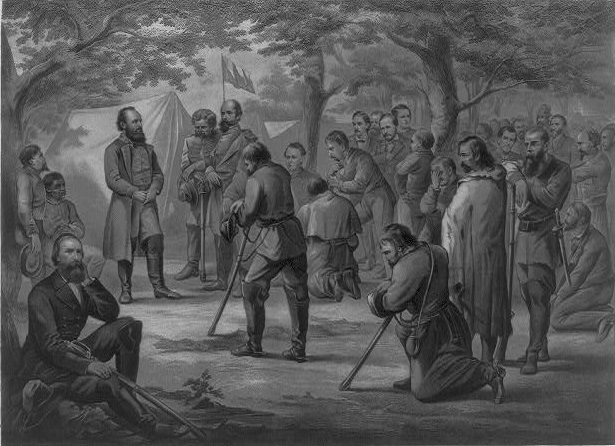The Great Civil War Revival: God at Work in Unlikely Places
Pastor Wes Shortridge presents a short history of the astounding revival that occurred on both sides of the American Civil War and how it impacted the nation for decades.
Introduction
America in 1861 presents a painful and complex chapter in history. God, however, had a plan for the American people, and God remained present during the painful chapter. God appears most in this period in the soldiers fighting the Civil War. Along the banks of the Rappahannock River in 1863, both armies faced one another in battle; however, both armies also faced a revival of religion. The paradox of revival in two armies facing one another presents an example of God’s ability to use revival to accomplish His purposes in spite of human conflict.
In the history of American revivals, the Civil War revivals mark a continuation of the Second Great Awakening.

“Prayer in ‘Stonewall’ Jackson’s Camp” (1866).
Drawn by F. Kramer, Engraved by J. C. Buttre.
The Circumstances of the Revival
Pre 1861 America While many modern interpreters of the American situation before the Civil War view the war as a simple moral war in which one party supported slavery and the other party arose as a benevolent deliverer of an oppressed people, the actual situation in America proved much more complex. Americans, from both North and South, had sanctioned or at least ignored slavery for nearly a century. White men ruled the country, and obvious examples of misogyny and racism rarely arose as issues in a land that voiced the values of liberty and equality. The powerful elites from both North and South worked to protect the prominent position of the light-skinned and masculine. The first and second Great Awakenings had revived religion in America, but paternalistic racism remained unaddressed. Religion focused mostly on benevolence within the paternalistic system rather than valuing or empowering all humans.
Slavery in America found support in the hermeneutical principles of American religion in both the North and the South. Mark A. Noll describes the unique hermeneutic of America:
Americans held to a hermeneutic that was distinctly American. The reason they held it so implicitly was precisely that this hermeneutic—compounded of a distinctly Reformed approach to the scope of biblical authority (“every direction contained in its pages as applicable at all times to all men”) and a distinctly American intuition that privileged commonsense readings of scriptural texts (“a literal interpretation of the Bible”)—had functioned as the vehicle through which the Bible was unleashed in the creation of the American civilization.[1]
While many modern interpreters view the Civil War as a simple moral war … the actual situation in America proved much more complex.
Category: Church History, Winter 2017


